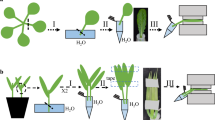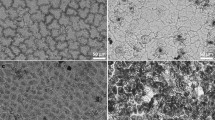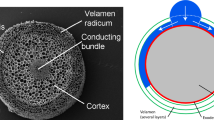Abstract
Size selectivity of aqueous pores in Vicia leaf cuticles was investigated by measuring the penetration of calcium salts into the abaxial surface of detached leaves. Molecular weights of salts ranged from 111 g mol−1 to 755 g mol−1. Penetration in light at 20°C and 100% humidity was a first order process and rate constants of penetration ranged from 0.39 h−1 (CaCl2) to 0.058 h−1 (Ca-lactobionate). Penetration was a first order process in the dark as well, but the rate constants were smaller by a factor of 1.82. Plotting logarithmatised rate constants versus anhydrous molecular weights resulted in straight lines both in light and in the dark. The slopes per hour were very similar and the average slope was −1.2×10−3 mol g−1. Hence, size selectivity was not affected by stomatal opening, and in light or darkness permeability of Vicia cuticles decreased by a factor of 2.9 when molecular weight increased from 100 g mol−1 to 500 g mol−1. Silver nitrate was preferentially precipitated as silver chloride in guard cells, glandular trichomes and at the base of trichomes. It was concluded that these precipitates mark the location of aqueous pores in Vicia leaf cuticles. The size selectivity of aqueous pores in Vicia leaf cuticles is small compared to that observed in poplar leaf cuticles, in which permeability decreased by a factor of 7–13 for the same range of molecular weights. It is also much smaller than size selectivity of the lipophilic pathway in cuticles. These findings suggest that active ingredients of pesticides, growth regulators and chemical inducers with high molecular weights penetrate leaves at higher rates when formulated as ions.






Similar content being viewed by others
Abbreviations
- CM:
-
Cuticular membrane
- EDX:
-
Energy dispersive X-ray
- LM:
-
Light microscope
- POD:
-
Point of deliquescence
- SEM:
-
Scanning electron microscope
References
Adkins SW, Tanpipat S, Warbrick JT, Boersma M (1988) Influence of environmental factors on glyphosate efficacy when applied to Avena fatua or Urochloa panicoides. Weed Res 38:129–138
Baur P (1997) Lognormal distribution of water permeability and organic solute permeability in plant cuticles. Plant Cell Environ 20:167–177
Baur P, Buchholz A, Schönherr J (1997) Diffusion in plant cuticles as affected by temperature and size of organic solutes: similarity and diversity among species. Plant Cell Environ 20:982–994
Buchholz A, Schönherr J (2000) Thermodynamic analysis of diffusion of non-electrolytes across plant cuticles in the presence and absence of the plasticiser tributyl phosphate. Planta 212:103–111
Buchholz A, Baur P, Schönherr J (1998) Differences among plant species in cuticular permeabilities and solute mobilities are not caused by differential selectivities. Planta 206:322–328
Chamel A, Pineri M, Escoubes M (1991) Quantitative determination of water sorption by plant cuticles. Plant Cell Environ 14:87–95
Eichert T, Burkhardt J (2001) Quantification of stomatal uptake of ionic solutes using a new model system. J Exp Bot 52:771–781
Franke W (1964) Role of guard cells in foliar absorption. Nature 202:1236–1237
Gatz C, Lenk I (1998) Promoters that respond to chemical inducers. Trends Plant Sci 3:152–358
Greene DW, Bukovac MJ (1974) Stomatal penetration: effect of surfactants and role in foliar absorption. Am J Bot 61:101–106
Greene DW, Bukovac MJ (1977) Foliar penetration of naphthaleneacetic acid: enhancement by light and role of stomata. Am J Bot 64:96–101
Holloway PG, Stock D (1990) Factors of affecting the activation of foliar uptake of agrochemicals by surfactants. In Karsa RD (ed) Industrial applications of surfactants II. Royal Society of Chemistry Special Publication No. 77, London, pp 303–337
Jepson I, Martinez A, Sweetmann JP (1998) Chemical-inducible gene expression systems for plants—review. Pest Sci 54:360–367
Knoche M (1994) Organosilicon surfactant performance in agricultural spray application: a review. Weed Res 34:221–239
Kolthoff IM, Sandell EB, Bruckenstein S (1969) Quantitative chemical analysis. Macmillan, London
Krüger J (1999) Mechanistische Untersuchungen zur Permeabilität der pflanzlichen Kutikula für Calciumsalze. Doct Thesis University of Hannover, Germany
Lord WG, Greene DW, Emino ER (1979) Absorption of silver nitrate and lead nitrate into leaves of McIntosh apple. Can J Plant Sci 59:137–142
Maier-Maercker U (1983) The role of peristomatal transpiration in the mechanism of stomatal movement. Plant Cell Environ 6:369–380
Riederer M, Schreiber L (1995) Waxes – the transport barriers of plant cuticles. In Hamilton RJ (ed) Waxes: chemistry, molecular biology and functions. The Oily Press, Dundee, pp 131–156
Schlegel TK, Schönherr J (2002) Selective permeability of cuticles over stomata and trichomes to calcium chloride. Acta Hort 549:91–96
Schönherr J (2000) Calcium chloride penetrates plant cuticles via aqueous pores. Planta 212:112–118
Schönherr J (2001) Cuticular penetration of calcium salts: effects of humidity, anions and adjuvants. J Plant Nutr Soil Sci 164:225–231
Schönherr J (2002) A mechanistic analysis of penetration of glyphosate salts across astomatous cuticular membranes. Pest Manag Sci 58:343–351
Schönherr J, Bukovac MJ (1972) Penetration of stomata by liquids. Plant Phys 49:813–819
Schönherr J, Bukovac MJ (1978) Foliar penetration of succinic acid-2,2-dimethyl hydrazide: mechanism and rate limiting step. Physiol Plant 42:243–251
Schönherr J, Luber M (2001) Cuticular penetration of potassium salts: effects of humidity, anions and temperature. Plant Soil 236:117–122
Schönherr J, Riederer M (1988) Desorption of chemicals from plant cuticles: evidence for asymmetry. Arch Environ Cont Toxicol 17:13–19
Schönherr J, Schreiber L (2004a) Size selectivity of aqueous pores in astomatous cuticular membranes isolated from Populus canescens (Aiton) Sm leaves. Planta 219:405–411
Schönherr J, Schreiber L (2004b) Interactions of calcium ions with weakly acidic active ingredients slow cuticular penetration: a case study with glyphosate. J Agric Food Chem 52:6546–6551
Schreiber L, Skrabs M, Hartmann K, Diamantopoulos P, Simanova E, Santrucek J (2001) Effect of humidity on cuticular transpiration of isolated cuticular membranes and leaf disks. Planta 214:274–282
Stein WD (1967) The movement of molecules across cell membranes. Academic, New York
Stevens PJG, Gaskin RE, Hong SO, Zabkiewicz JA (1992) Pathways and mechanisms of foliar uptake as influenced by surfactants. In Foy CL (ed) Adjuvants for agrochemicals. CRC, Boca Raton, pp 385–398
Tanpipat S, Adkins SW, Warbrick JT, Boersma M (1997) Influence of selected environmental factors on glyphosate efficacy when applied to awnless barnyard grass (Echinocloa colona L) Link. Aust J Agric Res 48:695–702
Acknowledgements
The authors gratefully acknowledge technical help in SEM and EDX analysis by Dr. Kerstin Koch and Hans-Jürgen Ensikat (NEES Institut für Biodiversität der Pflanzen, Universität Bonn) and financial support by the DFG to Lucas Schreiber.
Author information
Authors and Affiliations
Corresponding author
Rights and permissions
About this article
Cite this article
Schlegel, T.K., Schönherr, J. & Schreiber, L. Size selectivity of aqueous pores in stomatous cuticles of Vicia faba leaves. Planta 221, 648–655 (2005). https://doi.org/10.1007/s00425-005-1480-1
Received:
Accepted:
Published:
Issue Date:
DOI: https://doi.org/10.1007/s00425-005-1480-1




